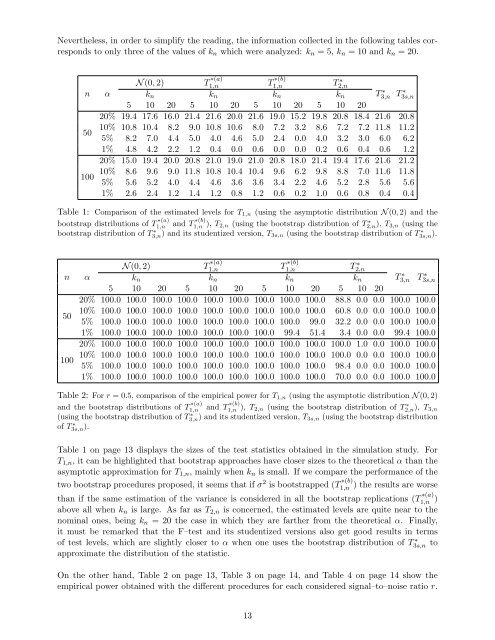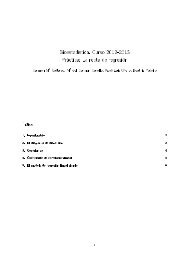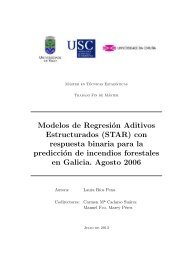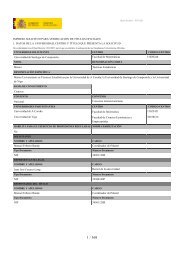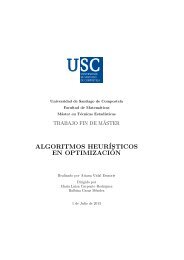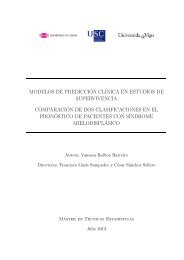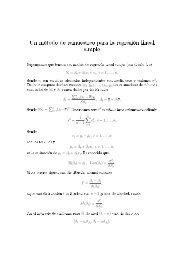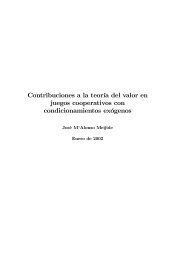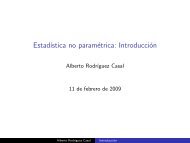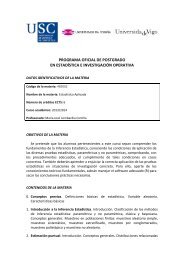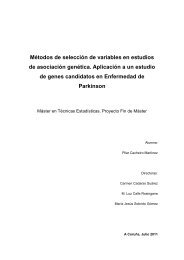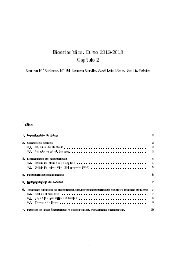Bootstrap independence test for functional linear models
Bootstrap independence test for functional linear models
Bootstrap independence test for functional linear models
You also want an ePaper? Increase the reach of your titles
YUMPU automatically turns print PDFs into web optimized ePapers that Google loves.
Nevertheless, in order to simplify the reading, the in<strong>for</strong>mation collected in the following tables correspondsto only three of the values of k n which were analyzed: k n = 5, k n = 10 and k n = 20.n50100N (0, 2) T ∗(a)1,n T ∗(b)1,n T2,n∗α k n k n k n k n T3,n∗ T 3s,n∗5 10 20 5 10 20 5 10 20 5 10 2020% 19.4 17.6 16.0 21.4 21.6 20.0 21.6 19.0 15.2 19.8 20.8 18.4 21.6 20.810% 10.8 10.4 8.2 9.0 10.8 10.6 8.0 7.2 3.2 8.6 7.2 7.2 11.8 11.25% 8.2 7.0 4.4 5.0 4.0 4.6 5.0 2.4 0.0 4.0 3.2 3.0 6.0 6.21% 4.8 4.2 2.2 1.2 0.4 0.0 0.6 0.0 0.0 0.2 0.6 0.4 0.6 1.220% 15.0 19.4 20.0 20.8 21.0 19.0 21.0 20.8 18.0 21.4 19.4 17.6 21.6 21.210% 8.6 9.6 9.0 11.8 10.8 10.4 10.4 9.6 6.2 9.8 8.8 7.0 11.6 11.85% 5.6 5.2 4.0 4.4 4.6 3.6 3.6 3.4 2.2 4.6 5.2 2.8 5.6 5.61% 2.6 2.4 1.2 1.4 1.2 0.8 1.2 0.6 0.2 1.0 0.6 0.8 0.4 0.4Table 1: Comparison of the estimated levels <strong>for</strong> T 1,n (using the asymptotic distribution N (0, 2) and thebootstrap distributions of T ∗(a) ∗(b)1,n and T1,n ), T 2,n (using the bootstrap distribution of T2,n), ∗ T 3,n (using thebootstrap distribution of T3,n) ∗ and its studentized version, T 3s,n (using the bootstrap distribution of T3s,n).∗n50100N (0, 2)T ∗(a)1,n T ∗(b)1,n T2,n∗α k n k n k n k n T3,n∗ T 3s,n∗5 10 20 5 10 20 5 10 20 5 10 2020% 100.0 100.0 100.0 100.0 100.0 100.0 100.0 100.0 100.0 88.8 0.0 0.0 100.0 100.010% 100.0 100.0 100.0 100.0 100.0 100.0 100.0 100.0 100.0 60.8 0.0 0.0 100.0 100.05% 100.0 100.0 100.0 100.0 100.0 100.0 100.0 100.0 99.0 32.2 0.0 0.0 100.0 100.01% 100.0 100.0 100.0 100.0 100.0 100.0 100.0 99.4 51.4 3.4 0.0 0.0 99.4 100.020% 100.0 100.0 100.0 100.0 100.0 100.0 100.0 100.0 100.0 100.0 1.0 0.0 100.0 100.010% 100.0 100.0 100.0 100.0 100.0 100.0 100.0 100.0 100.0 100.0 0.0 0.0 100.0 100.05% 100.0 100.0 100.0 100.0 100.0 100.0 100.0 100.0 100.0 98.4 0.0 0.0 100.0 100.01% 100.0 100.0 100.0 100.0 100.0 100.0 100.0 100.0 100.0 70.0 0.0 0.0 100.0 100.0Table 2: For r = 0.5, comparison of the empirical power <strong>for</strong> T 1,n (using the asymptotic distribution N (0, 2)and the bootstrap distributions of T ∗(a) ∗(b)1,n and T1,n ), T 2,n (using the bootstrap distribution of T2,n), ∗ T 3,n(using the bootstrap distribution of T3,n) ∗ and its studentized version, T 3s,n (using the bootstrap distributionof T3s,n).∗Table 1 on page 13 displays the sizes of the <strong>test</strong> statistics obtained in the simulation study. ForT 1,n , it can be highlighted that bootstrap approaches have closer sizes to the theoretical α than theasymptotic approximation <strong>for</strong> T 1,n , mainly when k n is small. If we compare the per<strong>for</strong>mance of thetwo bootstrap procedures proposed, it seems that if σ 2 is bootstrapped (T ∗(b)1,n ) the results are worsethan if the same estimation of the variance is considered in all the bootstrap replications (T ∗(a)1,n )above all when k n is large. As far as T 2,n is concerned, the estimated levels are quite near to thenominal ones, being k n = 20 the case in which they are farther from the theoretical α. Finally,it must be remarked that the F–<strong>test</strong> and its studentized versions also get good results in termsof <strong>test</strong> levels, which are slightly closer to α when one uses the bootstrap distribution of T ∗ 3s,n toapproximate the distribution of the statistic.On the other hand, Table 2 on page 13, Table 3 on page 14, and Table 4 on page 14 show theempirical power obtained with the different procedures <strong>for</strong> each considered signal–to–noise ratio r.13


